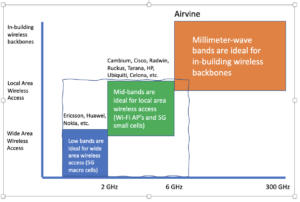In this blog, we will explore the RF bands commonly used today to identify the best frequency bands for backhaul and understand which services work best at which frequencies. We will examine access technologies that connect users to Wi-Fi APs (or cellular networks) and backbone technologies that link these APs back to the wiring closet and then to the Internet.
Overview of RF Spectrum
RF spectrum can be divided into low bands, mid-bands, and high bands (aka millimeter-wave).
Low Bands (Below 2 GHz)
Typically, experts define the low bands as frequencies below 2 GHz, and these bands propagate extremely well. If you’ve ever wondered why your cellphone works in an underground parking garage, it’s probably because the network uses the 850 MHz band. At these frequencies, signals bounce down concrete stairwells and eventually reach you and/or your car. These bands also penetrate office buildings, easily passing through most types of exterior and interior walls. Although not usually considered the best frequency bands for backhaul due to limited spectrum and high demand, the low bands excel in providing wide area coverage. Of course, the available spectrum determines the capacity that a given wireless system can support—more Hz means more bits per second.
Mid-Bands (2GHz to 6GHz)
As you move into the mid-band, ranging from 2GHz to roughly 6GHz, you will notice changes. The signals don’t travel as far, and they struggle more to penetrate structures, yet they still offer excellent local area coverage. Wi-Fi technology has established itself in the mid-bands. These bands provide a perfect environment for Wi-Fi due to their good, but not great, propagation characteristics, which enable better spectral reuse than the low bands. This advantage is crucial in unlicensed bands because it helps reduce interference.

Bottom line: the bands below 6 GHz are ideally suited to supporting access technologies. Wi-Fi and cellular technologies dominate this space and do a wonderful job of providing coverage. The downside of the low and mid-bands is reduced spectral reuse. Propagation isn’t always your friend. While these bands are primarily for access, it’s possible to also use them for backhaul, but this application is not their sweet spot. Remember backhauling by its very nature is a high-capacity use case. The backhaul network element must carry traffic from multiple access nodes, cellular or WiFi.
Challenges in using the low and mid-bands for backhaul
- Spectrum is precious in these bands as indicated by the money raised @ FCC auctions and the near-constant demand for more Wi-Fi capacity.
- As a result, there isn’t enough spectrum in these bands to come even remotely close to meeting the throughput demands for a backhaul application.
- The spectral reuse in these bands is sub-optimal which limits overall network capacity.
The 5.8 GHz band, a high-power unlicensed band (30 dBm in the U.S.), receives the most use in backhaul applications within the sub-6 GHz range. Companies including Tarana, Cambium, Ubiquiti, and Radwin operate in this band, focusing primarily on fixed wireless access (FWA) in rural areas. This usage establishes 5.8 GHz as one of the best frequency bands for backhaul, especially when applications require high power and extensive coverage. Base stations, mounted on towers or grain silos, connect users several kilometers away. However, the limited spectrum (125 MHz in the U-NII-3 band) restricts the throughput.
Wi-Fi mesh technology can also be used to provide backhaul in the sub-6 GHz bands. In this application, a Wi-Fi AP is used to provide both access and backhaul. This has the effect of cutting the capacity of the AP in half, which can be a problem depending on the application.
Other challenges using Wi-Fi for backhaul include:
- Practical channel widths are usually limited to at most 160 MHz and usually far less, meaning lower throughputs.
- Backhauling over Wi-Fi is the best effort.
- Spectral reuse is low at these frequencies as signals can propagate widely throughout the enterprise.
- The signal can easily escape the building, so security can be an issue.
- The 6GHz band which newer WiFi 7 equipment can operate in, still lacks the spectrum needed for backhauling and is needed for access.
This approach offers an inexpensive way to provide coverage over wide areas, such as parks, but the coverage incurs a significant loss in capacity with each hop. This significant capacity loss makes it unsuitable for most broadband enterprise backbone applications.

We now turn to the millimeter-wave or high bands. These frequencies offer a tremendous amount of spectrum, but their propagation characteristics are much more limited. The unlicensed V-band at 60 GHz (57-71 GHz in the U.S.) has attracted the most interest within the millimeter-wave band. Although this band can easily match fiber speeds, it does not propagate very well.
Challenges with the V-band include:
- Free Space Path Loss (FSPL) as defined by FRIIS = 32.4 + 20Log10(d) + 20Log10(f) where d is in kilometers and f is in MHz. At 100 meters, you’ll see close to 110 dB of path loss @ 60 GHz.
- This band suffers from an effect called oxygen absorption. Losses from oxygen absorption can approach 16 dB per kilometer (FCC paper referenced below).
- Loss from heavy rain can add another 21 dB per kilometer (FCC paper referenced below).
- Diffraction is very poor at 60 GHz. The wavelength of V-band signals is just too short to bend around obstructions.
- Signals have difficulty passing through walls, furniture, trucks, billboards, equipment, and especially people.
The net result? Radios using this band have limited distance and line-of-sight restrictions.
FCC Bulletin #70 from 1997 is still the single best treatise on the physics of millimeter-wave propagation that I’ve ever come across.
Beamforming and High-Frequency Benefits
This might all sound challenging, but it depends on what you are trying to do. When identifying the best frequency bands for backhaul, particularly in building enterprise backbones, these negatives either become positives or they simply don’t apply. The FSPL is partially compensated with efficient beamforming, which is a hallmark of high-frequency bands. Airvine WaveTunnel™ uses a very small antenna operating at 60 GHz. These beams are only a few centimeters wide at 50 meters, and when you add in side lobe suppression, you get a system that supports very high spectral reuse. In a large warehouse, you’d be able to use the same V-band channel dozens of times without any noticeable co-channel interference.
 The V-band can deliver an enormous amount of network capacity for in-building backbone applications. Orders of magnitude more than is possible in the sub-6 GHz band.
The V-band can deliver an enormous amount of network capacity for in-building backbone applications. Orders of magnitude more than is possible in the sub-6 GHz band.
In summary, the sub-6 GHz bands are well suited to access. The millimeter-wave bands can support the capacities needed for an indoor backhaul solution. But unless your solution can overcome line of site restrictions it is of little practical use. The WaveTunnel has solved this problem and punches through walls—the world’s only Non-Line of Site 60GHz radio on the market.
For more on the capabilities of different frequency bands, reach out!
Originally Posted on August 20, 2021 by Steve Hratko